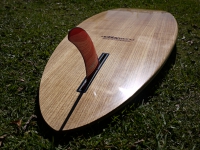Article chapter-3
Text by Nobby
1890年代以降、板子乗りの技術は波乗り人口が増えると共に向上して行き、
1909年7月には大磯で板子による競技会が行われる程になりました。
After the 1890's, Itago riding skill improved
with the growth of the Itago rider population.
And so, an Itago riding competition was held at Oiso in July 1909.
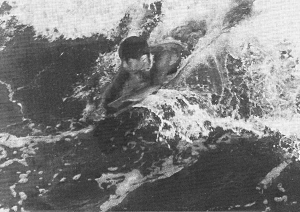
片瀬/ 1938年頃
Katase/ Circa1938
出典: 「湘南再発見」 吉田克彦著
この頃には、船大工に注文して自分専用の板子を持つ者が出てきました。
寸法は、長さ二尺から四尺(約60cm~120cm)
幅一尺から一尺五寸(約30cm~45cm)
厚さ七分から一寸 (約2cm~3cm)
材質は、杉が多く使われ、まれに桐を使う者もいました。
または代用品として家庭にあった洗濯板を使う者もいました。
Around that time, a lot of Itago were made for wave riding
by shipwrights for personal use.
The dimensions of Itago were length: 60cm~120cm,
width: 30cm~45cm, thickness: 2cm~3cm.
Most of the boards were made of Japanese cedar,
although a few were made of Paulownia.
On the other hand, some surfers used old-fashioned wood washboards
as substitute Itago.
大磯町郷土資料館所蔵/飯田福信氏撮影
多くの板子はロッカーが無くフラットな四角いアウトラインの板でした。
ノーズに持つ為の穴が開けられた物が多い中で、
ライディング時に穴から水が吹き出し顔に当たるのを嫌がり、
穴を開けなかった板子もありました。
Almost all Itago were flat with no rocker and had a rectangle outline
with a handle hole in the nose.
However, some surfers didn't make a handle hole
because they didn't like the water that came out of the handle hole
and hit them in the face when riding.
飯田善雄氏所蔵
Courtesy / Yoshio Iida
板子は板を縦向きで乗る"タテ乗り"が基本的な乗り方でしたが、
サイズのあるほれた波のテイクオフでは
板を横向きにして乗る"ヨコ乗り"でボトムまで滑る乗り方もありました。
Generally, the itago was held vertically. This riding style was called 'Tate-nori'.
However, when taking off on a big, steep wave,
it was held horizontally like 'Side slipping'.
That riding style was called 'Yoko-nori'.
タテ板 / 飯田福信氏撮影
ヨコ板 / 飯田福信氏撮影
「游泳法と其實際」
「The method of swimming and practice」
1914 (大正3年)
津崎亥九生 著
Author : Ikuo Tsuzaki
「(前略)濤頂の将さに崩れんとするときに、
頭部を下げ兩輪伸を用いて濤を貫くのである。(以下略) 」
When a swell is about to break, you must go through the swell
with the face down and a swimming stroke like breaststroke.
「濤乗には、浅瀬にてするものと、底深き所よりするのとの二種類がある。
Body surfing has two types of methods,
one for shallow water and another one for deep water.
浅瀬にて乗るには、濤頂が凡一間位の後方に來たときに
足尖にて水底を蹴つて足尖と濤頂に入れ
兩臂を前方に伸ばして躄脚を急速に行ひ、
十分に濤に乗り切れたる時に蹙足を止めて之を伸ばし、
濤頂と共に進退するのである。(第八十三圖)
In the shallow water, when a swell comes behind about 180cm
push off the bottom with your toes
and soon after set your toes in the crest of a wave.
After that, stretch both your elbows forward and do flutter kicks rapidly.
When you are riding the crest of a wave with sufficient speed,
stop flutter kicks and stretch your legs.
然れども未熟の間は濤に捨てられて取り残さるゝ事があるから、
其時には一方の臂を前方に伸ばし、
他の臂にて小さき抜手を用ひて其前進を助くるがよい。
In the case of a beginner, who can't keep riding on the wave and is left behind.
To protect from that case, stretch one of your hands forward
and with your other hand you must do an overhand short stroke.
This will be a good support when riding on the wave.
板子を使用する時は使用せざるに比して容易に乗る事が出来る。
It's easier to ride on the wave with an 'Itago' than body surfing.
板子の一端を左(右)の下腹に接し、
左(右)臂を伸ばして第八十四圖に示すが如く軽く板の先端を押へ
右(左)臂を伸ばして左(右)臂に添へ脚は急速に蹙足を用ひ
全く乗り終りたる時に脚を伸ばして濤頂と共に進む、
Place one end of the 'Itago' on the left (or right) side,
Stretch your left (or right) elbow forward
and hold the 'Itago' lightly as in the above illustration.
After that, stretch your right(or left) elbow forward
and follow the other hand and do flutter kicks rapidly.
When you are riding the crest of a wave with sufficient speed,
stop flutter kicks and stretch your legs.
板子使用の場合には板先を少し上ぐることに注意さぜる時には
板の濤中に入りて體を轉倒されることがある。
If you don't take care to keep the nose up a little bit,
the 'Itago' will go under the water and you will wipe out.
深き所にて游ぎ居るときに乗らんとするときには
濤頂が體の後方三尺位の所に來りて體の後半部上揚するとき、
體の前半部を少しく下げて両臂を伸し、
兩脚を伸すや直ちに小さき蹙足を用ゐ、
全く乗り終りたるときに蹙足を止めて脚を伸ばす。」
When you hope to take off swimming in deep water.
When a swell comes behind about 90cm
and the lower half of the body is being lifted above.
Put the upper half of the body a little bit down
with a stretch of both your elbows and legs.
And then, immediately do short flutter kicks.
Stop the flutter kicks and stretch your legs when you finish riding.
兩輪伸とは、腕は今で言う平泳ぎ、
脚は扇足(あおりあし)の動作を組み合わせた古流の泳法。
蹙足はバタ足。片腕を前方に伸ばし、
反対の腕でクロール(抜手)をする動作や波に乗った姿勢は、
現在のボディサーフィンと同じ技術である。
図に描かれた、腕と脚を伸ばした抵抗が少ない姿勢で波頂とともに前進する泳者は、
安定すると同時に躍動感があり、当時の技術の高さを示している。
(note for Japanese/Susumu Tsuji)
敬文館
波乗りフロート
Japanese hollow wooden board
"Naminori Frouto"
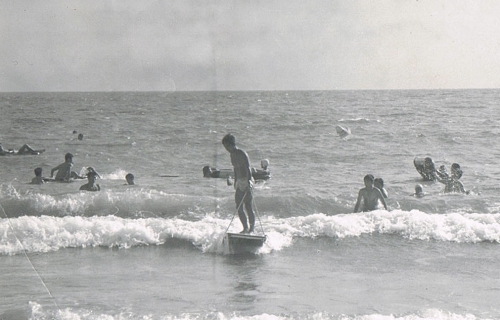
逗子 / 昭和37年
塚越東男氏所蔵
Zushi / 1962
Courtesy / Haruo Tsukakoshi
Circa 1930, One American guy brought 9ft solid wood board
with a rope on the front of the deck from Hawaii.
I guess it was "Aquaplane"but it was used for water skiing and not for surfing.
A Kamakura shipwright who nickname was "Yone-san"improved it
by making a hollow board "Naminori Furouto"with a rope on the front of the deck
for a costomer "Yoshinobu Masuda" an artist lived in Hase Kamakura in 1931.
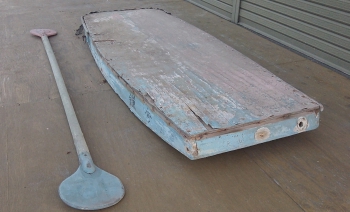
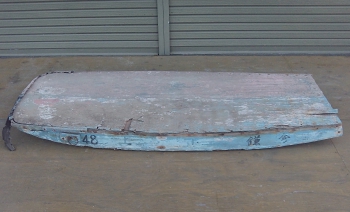
場所:材木座、神奈川
年代:1960年代
所有:Nobby
Place: Zaimokuza, Kanagawa
Date: 1960's
Collection: Nobby
長さ (Length) / mm (inch)
幅 (Width) / mm (inch)
厚さ (Thickness) / mm (inch)
"Naminori Furouto" was very popular in Kamakura in the 1950’s and 60's.
Every local guys surfed with it and a lot of sea bathers rented it.
Some people used paddle when they surfed it as like SUP.
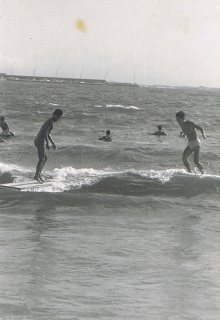
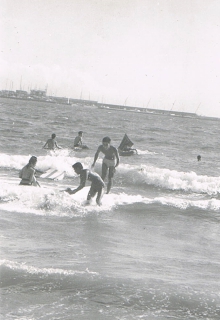
逗子 / 昭和37年
塚越東男氏所蔵
Zushi / 1962
Courtesy / Haruo Tsukakoshi
Editing
Article chapter-4
"History of Japanese modern surfing"
Text by Nobby
1920年代後半(昭和初期)
神奈川県・茅ヶ崎の森信次郎氏が、9ftの木製ワイキキボードを
ハワイから持ち込み、スタンディングサーフィンを始める。
Late 1920's, a 9ft waikiki board was brought by Shinjiro Mori from Hawaii
He lived in Chigasaki, Kanagawa.
1931年頃(昭和6年頃)
神奈川県・鎌倉の船大工達が、波乗りフロートを作り始める。
Around 1931, a hollow wood board that was called a 'Float' in Japan
was made by Kamakura, Kanagawa shipwrights.
第二次世界大戦後(1945~)、
マットサーフィンによるサーフィンが駐留米軍兵士によって持ち込まれ、
一般客用に貸し出されていた海水浴場での板子での波乗りは
エアーマットによるマットサーフィンに変わって行きました。
そして1970年代後半以降、ボディボードの登場により
その姿は殆ど見られなくなりました。
After World War Ⅱ(Post 1945)
Soldiers in the American occupation army brought surf mats to Japan,
so riding Itako changed to surfing rubber mats at bathing beaches.
After that Itago almost disappeared with the introduction of foam bodyboards
in the late 1970's.
1959年(昭和34年)
大館勲氏が10ftのフォームサーフボードをハワイから持ち込み、
材木座でサーフィンを始める。
東京都・北千住の高橋太郎氏がホローウッドのサーフボードを作る。
In 1959, a 10ft foam surfboard was brought by Isao Oodate from Hawaii
and surfed at Zaimokuza, Kanagawa.
Taro Takahashi made his first hollow wood surfboard at Kitasenjyu, Tokyo.
1963年(昭和38年)
高橋太郎氏が'DUCKS'サーフボードの販売を始める。
東京都・入船の米沢プラスチク社が国産のブランクスを製作し、
'MALIBU'ブランドのサーフボードを販売する。
ブルースブラウン氏がデルキャノン、ペータージョンソン両氏と
映画撮影の為に神奈川・千葉を訪れる。
In 1963, Taro Takahashi's "DUCKS surfboards" came out with a urethane blank.
The first domestic urethane blank was made by 'Yonezawa' Plastic company at Irifune, Tokyo and "MALIBU surfboards" were developed and marketed by that company.
Bruce Brown came to Chiba and Kanagawa for his surf movie
with Del Cannon and Peter Johnson.
1964年(昭和39年)
千葉県・鴨川で全日本サーフィン大会が行われる。
In 1964, the first surfing competition was held at Kamogawa, Chiba.

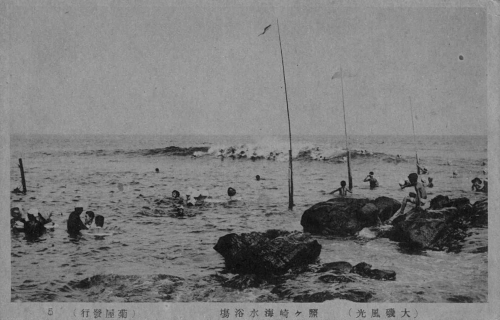
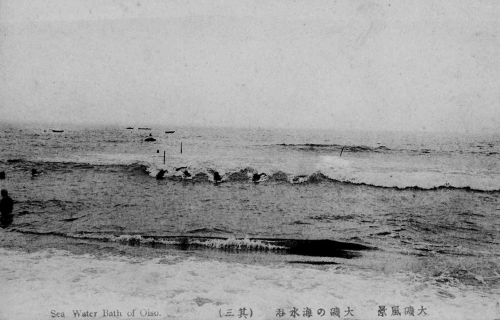
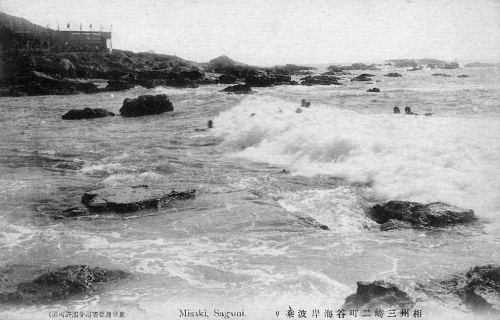
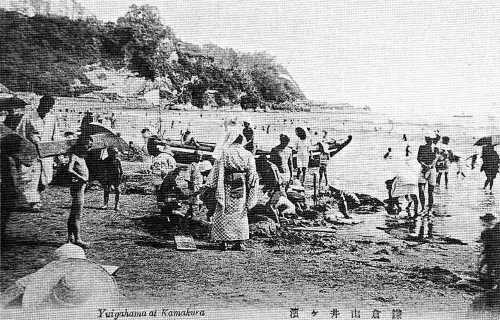
 contact > Nobby
contact > Nobby

